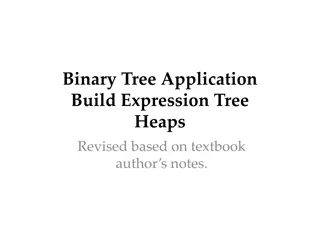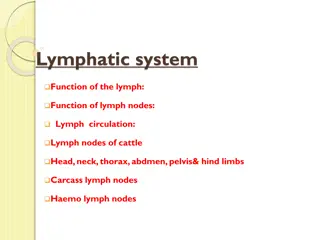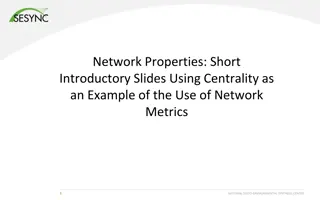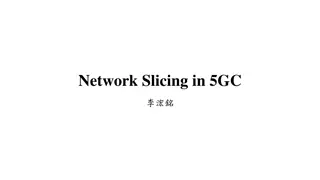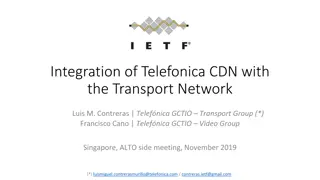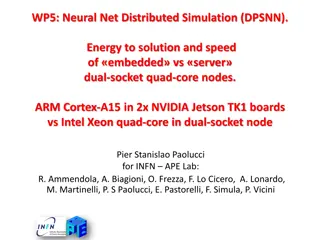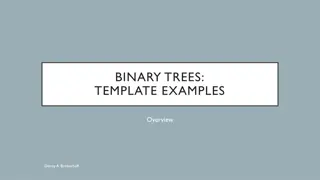UML Deployment Diagrams
UML Deployment Diagrams show the execution architecture of software systems, illustrating how software deployment targets are assigned artifacts to nodes. Nodes represent hardware devices or software environments connected through communication paths, while artifacts are concrete elements deployed o
9 views • 22 slides
Byzantine Fault Tolerance in Distributed Systems
Byzantine fault tolerance is crucial in ensuring the reliability of distributed systems, especially in the presence of malicious nodes. This concept deals with normal faults, crash faults, and the challenging Byzantine faults, where nodes can exhibit deceptive behaviors. The Byzantine Generals Probl
2 views • 29 slides
Role of Lymphadenectomy in Genital Malignancies
Pelvic and paraaortic lymph node evaluation is crucial in the surgical staging of gynecological malignancies. The goals of lymph node dissection are to determine disease extent and guide further treatment. Pelvic lymph nodes include common iliac, external and internal iliac, obturator, sacral, and p
3 views • 16 slides
Redis Cluster Distribution Approach
Redis Cluster offers a pragmatic approach to distribution, connecting all nodes directly with a service channel. Each node communicates using a binary protocol, optimized for bandwidth and speed. Nodes do not proxy queries, and communication involves messages like PING, PONG, and Gossip. Hash slot k
2 views • 17 slides
Doubly Linked Lists in C Programming
A doubly linked list in C comprises nodes with pointers to the next and previous nodes. Managing two sets of pointers can be complex, but adds flexibility for adding and removing nodes dynamically. This post explores the structure, implementation, and examples of doubly linked lists in C.
1 views • 13 slides
Economic Models of Consensus on Distributed Ledgers in Blockchain Technology
This study delves into Byzantine Fault Tolerance (BFT) protocols in the realm of distributed ledgers, exploring the complexities of achieving consensus in trusted adversarial environments. The research examines the classic problem in computer science where distributed nodes communicate to reach agre
2 views • 34 slides
Expression Tree Construction: Building Fully Parenthesized Expression Trees
In the process of building expression trees, nodes are inserted based on operators and operands, creating a fully parenthesized expression. The construction involves parsing the expression, inserting new nodes as tokens are examined, and linking nodes accordingly. By following the steps for handling
0 views • 17 slides
Trees and Binary Trees in Data Structures
A tree in data structures is a finite set of nodes with a designated root and subtrees, including internal nodes and leaf nodes. Terminology like root, parent nodes, leaves, and levels are explained, along with concepts of height and degree of a tree. Additionally, binary trees are introduced as a s
3 views • 94 slides
Interconnection Networks Topology
Exploring the topology of interconnection networks helps determine the arrangement of channels and nodes, impacting network cost, performance, latency, energy consumption, and complexity of implementation. Abstract metrics such as degree, hop count, and network diameter play crucial roles in evaluat
4 views • 56 slides
Centrality Measures in Peer-to-Peer and Social Networks
Centrality measures in networks quantify the importance of nodes based on their influence, accessibility, and role as connectors. Important centrality measures include Degree centrality (based on the number of connections), Closeness centrality (based on short paths to other nodes), and Betweenness
1 views • 27 slides
The Lymphatic System: Functions and Components
The lymphatic system is a vital network of organs, nodes, ducts, and vessels that maintains fluid balance, aids in immunity, and removes waste from tissues. It works in conjunction with the circulatory system to deliver essential nutrients and oxygen to cells. Key components include the thoracic duc
2 views • 14 slides
Exact Byzantine Consensus on Undirected Graphs: Local Broadcast Model
This research focuses on achieving exact Byzantine consensus on undirected graphs under the local broadcast model, where communication is synchronous with known underlying graphs. The model reduces the power of Byzantine nodes and imposes connectivity requirements. The algorithm involves flooding va
5 views • 7 slides
The Lymphatic System in Cattle: Nodes, Circulation, and Function
The lymphatic system in cattle plays a crucial role in maintaining overall health. It consists of lymph nodes located in various regions of the body such as the head, neck, abdomen, and hind limbs. These lymph nodes produce lymphocytes and help in filtering foreign bodies. Lymph fluid, similar to bl
3 views • 39 slides
Network Metrics Through Centrality Analysis
This presentation introduces network metrics as tools to describe network characteristics and answer important questions. Using centrality metrics as an example, participants learn how to identify the most important nodes in a network based on different criteria such as degree centrality and closene
3 views • 15 slides
Network Analysis: Whole Networks vs. Ego Networks
Explore the differences between Whole Networks and Ego Networks in social network analysis. Whole Networks provide comprehensive information about all nodes and links, enabling the computation of network-level statistics. On the other hand, Ego Networks focus on a sample of nodes, limiting the abili
10 views • 31 slides
Virtual Network Mapping: A Graph Pattern Matching Approach
Virtual Network Mapping (VNM) involves deploying virtual network requests in data center networks in response to real-time demands. It facilitates the deployment of virtual networks on physical machines by mapping virtual nodes and links onto substrate nodes and paths, ensuring constraints are met.
4 views • 15 slides
Return Dispositions and Remote Returns Process in Warehousing
Explore the concept of return dispositions like NRFI, RFI, UNS, and UNSNWT in warehouse management, along with insights into Remote Returns Process (RRP) nodes and Non-RRP nodes. Learn about Regular Returns, LPNs, and the choice between consolidating returns with LPNs for efficiency. Understand the
1 views • 11 slides
Deployment Viewpoint for MOIMS Services in SEA Reference Architecture
Identification of physical nodes and their connections, functional deployments showcasing interoperable interfaces between nodes, and classification of space and earth user nodes in the context of MOIMS services for the SEA reference architecture.
1 views • 17 slides
Network Slicing in 5GC
Network slicing in 5G Core (5GC) enables the creation of multiple virtual networks on a single physical infrastructure to cater to diverse requirements. The Non-Roaming 5G System Architecture outlines the reference points and functions involved in a 5G system. Service-Based Architecture (SBA) and Ne
0 views • 45 slides
2-3 Trees and Red-Black Trees
A detailed exploration of 2-3 trees and red-black trees, including definitions, properties, node structures, and traversal methods. Learn about the characteristics of 2-3 trees such as internal nodes with two or three children, maintaining leaves at the same level, and height constraints based on no
0 views • 70 slides
Update to Current Upstream Equivalent Object for Top Downstream Node
Downstream BOM now links to updated equivalent upstream parts, ensuring all top nodes are in sync. Check out downstream nodes with upstream children for a streamlined process. Green checkboxes signify completion, while the clock icon indicates nodes in need of iteration. Stay efficient with the late
1 views • 4 slides
Integration of Telefonica CDN for Efficient Network Delivery
Telefonica is integrating its CDN with the transport network to enhance content delivery efficiency and network awareness. By making the CDN transport network aware, Telefonica aims to improve adaptability to network changes and provide real-time insights for optimal content delivery. The integratio
2 views • 6 slides
Network Navigation Models and Local Information
In this study, the focus is on network navigation models and the importance of utilizing local information for efficient routing. Different network models and navigation strategies are explored, emphasizing the significance of heuristics and algorithms for finding well-connected nodes in large-scale
0 views • 22 slides
Binary Search Trees: Properties and Limitations
Binary search trees (BST) are binary tree data structures with specific properties regarding the values stored in nodes. This includes the left subtree containing nodes with lesser values and the right subtree containing nodes with greater values. However, BSTs have limitations such as average searc
3 views • 21 slides
Neural Net Distributed Simulation: Energy and Speed of Embedded vs Server Nodes
This study compares the energy efficiency and processing speed of ARM Cortex-A15-based NVIDIA Jetson TK1 boards and Intel Xeon-based dual-socket nodes for distributed simulation using DPSNN. The research, conducted by Pier Stanislao Paolucci at INFN APE Lab, focuses on optimizing performance trade-o
5 views • 13 slides
Performance Study of Big Data on Small Nodes
Big data poses challenges for traditional processing nodes due to their high energy consumption and cost. The case study explores the use of mobile nodes as a more energy-efficient and cost-effective solution, comparing traditional nodes like the Odroid XU and Supermicro 813M. Additionally, benchmar
3 views • 29 slides
Enhancing Mobile Ad-Hoc Network Resilience
The effects of adding arbitrary physical nodes to a mobile ad-hoc network utilizing an anonymity system. Analyze project goals, issues with original goals, evolution of goals, and the role of arbitrary physical nodes to strengthen the network. Delve into anonymous routing protocols and solutions usi
2 views • 25 slides
Introduction to Network and Security Concepts
Explore the fundamental definitions and concepts in computer networks and security, including OSI model, network architectures, security triad, and challenges in computer security. Learn about the interconnected lines in a network arrangement and the sharing of resources among network nodes. Dive in
2 views • 35 slides
Nodes, Devices, and Networks in a Local Area Network
Explore the key components of a network including nodes, peripheral devices, computers, and servers. Learn about different types of workstations and servers, as well as network setups like LAN and MAN. Dive into the world of peer-to-peer networking and understand the different types of servers that
1 views • 11 slides
Binary Trees Template Examples and Implementation Guide
Delve into the world of binary trees with detailed examples and a comprehensive guide on creating, manipulating, and removing nodes in binary tree structures. Learn the step-by-step process for implementing binary trees and efficiently managing tree nodes. Explore various scenarios for removing node
0 views • 10 slides
ASTs Representation in Java Objects
In Compiler Construction, understanding how Abstract Syntax Trees (ASTs) can be represented as Java objects is crucial. This involves parser actions, operations on ASTs, modularity, encapsulation, and utilizing the Visitor pattern. The MiniJava Project focuses on Compiler Construction concepts such
4 views • 18 slides
Balanced 3-Way Search Tree Structure Overview
Explore the concept of a balanced 3-way search tree structure with internal nodes as 2-nodes or 3-nodes and leaf nodes containing one or two data elements. Learn about the differences between Binary Search Trees and 2-3 Trees, their characteristics, and advantages. Discover the features and insertio
0 views • 19 slides
Network Nodes and Types in Local Area Networks
Explore the fundamental components of a network, including nodes such as peripheral devices, computers, and network equipment. Learn about the different types of workstations and servers, and understand concepts like LAN and MAN networks. Discover various network approaches like peer-to-peer network
2 views • 11 slides
Carcass Lymph Nodes and Their Importance in Meat Hygiene
Explore the significance of carcass lymph nodes in meat hygiene, their drainage patterns, and their role in assessing diseases like T.B. Discover how lymph nodes in the carcass are key indicators of the animal's health status.
3 views • 12 slides
Hypertext Terminology in Web Infrastructure
Nodes, links, anchors, and endpoints are essential elements in understanding hypertext terminology in web infrastructure. Dr. Nicholas Gibbins provides insights into these components and their relationships, along with detailed explanations and examples. Explore the significance of nodes as semantic
0 views • 23 slides
Managing Network Operations Model Resource Nodes
NPRR 1099 focuses on DGR modeling, resource retirement, and POI changes in the ERCOT network operations. It differs from NPRR 1017, emphasizing managing resource nodes effectively for transmission and distribution. Explore examples illustrating the impact of NPRR implementations on network infrastru
0 views • 22 slides
Enhancements and Functions of GPRS Network Nodes
Discover the functions of Supporting Nodes SGSN and GGSN, as well as GPRS network enhancements including BSS upgrades and network layer protocols. Explore how these nodes manage packet switching, routing, mobility, authentication, and more within the GPRS network architecture.
1 views • 33 slides
Understanding CFG Nodes and Information Loss in Program Semantics
Explore the concept of Control Flow Graph (CFG) nodes and information loss in program semantics. Learn how nodes store constant values and how imprecise information at one point can lead to the loss of other crucial data, impacting program understanding.
2 views • 4 slides
Disjoint Set Union: Path Queries and Node Connections
Learn about Disjoint Set Union (DSU) data structure for handling queries like adding edges between nodes and checking path existence. Understand how nodes are connected and parent nodes are determined using DSU.
2 views • 28 slides
Understanding Blockchain Consensus and Nodes
Explore the concept of consensus in blockchain technology, including the importance of achieving agreement among nodes for system integrity. Learn about the different types of nodes in a blockchain network and their roles in maintaining consensus and security.
1 views • 33 slides






